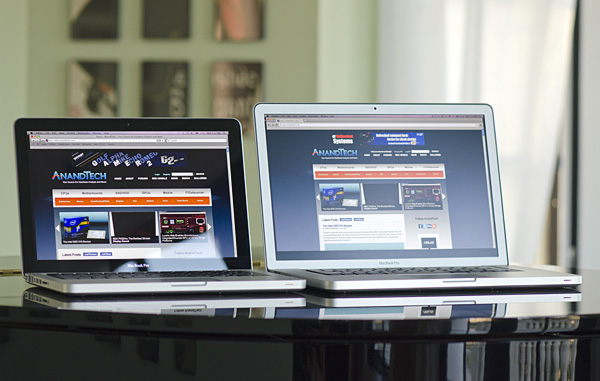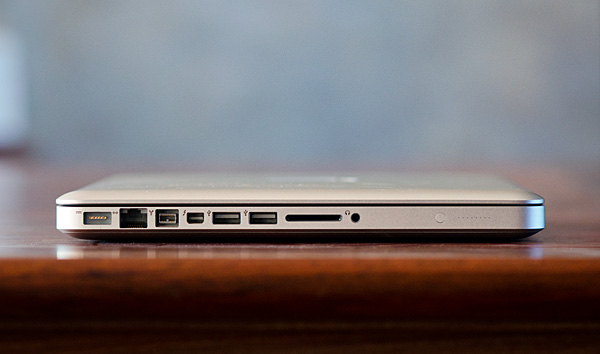The MacBook Pro Review (13 & 15-inch): 2011 Brings Sandy Bridge
by Anand Lal Shimpi, Brian Klug & Vivek Gowri on March 10, 2011 4:17 PM EST- Posted in
- Laptops
- Mac
- Apple
- Intel
- MacBook Pro
- Sandy Bridge
Final Words
For as little attention as the 2011 MacBook Pro launch was given by Apple, there sure is a lot to talk about.
The advantages are numerous. With the 13-inch MacBook Pro, under OS X at least, there simply aren't any downsides. You get much better CPU performance over the previous generation. In fact, the new 13 can outperform last year's 15 thanks to Sandy Bridge. The new 13 is quite possibly the best balance of portability and performance. It's the single largest upgrade you'll find in the lineup. If you own a previous generation 13-inch MBP, the upgrade is 100% worth it. Graphics performance is solid under OS X however questionable under Windows. For some reason we actually saw a step back in GPU performance vs. last year's 13-inch MBP when running games in Windows 7.
The 15-inch MacBook Pro is a beast. Although it comes in the same chassis as last year's model, it delivers much more performance. The move to quad-core Sandy Bridge makes the 15-inch MacBook Pro's performance formidable. Whereas I couldn't use the 2010 15 as my primary work machine, with an SSD the 2011 15-inch MBP does just fine.
Displays haven't really changed, which is both good and bad. On the one hand, Apple's MacBook Pros have always used good quality panels. On the other hand I'd like to see a higher res option for the 13-inch display—1280 x 800 is a big turnoff for me with the 13-inch model.
Thunderbolt is a nice addition however I expect that it'll be grossly underused for a while. We'll see some nice Thunderbolt enabled external storage solutions this Spring (helping perpetuate the mobile desktop usage model), but it'll be a while before we get the single-cable carrying USB, Ethernet, FireWire and DisplayPort to a display.
The WiFi improvements are welcome, although surprisingly absent from Apple's marketing collateral. The front facing 720p camera is also a nice touch.
It's not all rosy however. Apple fails to really take advantage of one of Sandy Bridge's biggest features: Quick Sync. The hardware encoder is used in FaceTime HD but you still get some very high CPU usage (at least of a single core). There's no support in QuickTime or iMovie 2011 for Quick Sync as of now, which is a major disappointment.
I mentioned that the 15-inch MacBook Pro is easily a desktop replacement, however you do have to deal with a loud fan under heavier CPU loads. Something a well designed desktop won't bother you with.
SSD support is still problematic. There are far too many reports of drives that don't work properly in the 2011 MacBook Pro, and Apple refuses to validate/ship anything but fairly mainstream SSD solutions. To make matters worse, although TRIM is finally enabled under OS X—it only works on Apple branded SSDs. I can understand Apple's desire to want to avoid dealing with the pitfalls of early SSDs with questionable firmware maturity, but I also believe it's Apple's duty to support as much hardware that's out there in the market today. If Apple offered something with SandForce SF-2200 class performance I'd have less of a bone to pick, but presently it doesn't.
Then there are the concerns about battery life. Under light usage there's a clear improvement over last year's models. The new 15-inch MacBook Pro is good for anywhere between 7—9 hours of light usage. That is assuming you don't have the dGPU running of course, at which point you should start talking about numbers below 5 hours. Even without the discrete GPU enabled, in the hands of a multitasker the new 15-inch MacBook Pro can easily burn through its 77Whr battery quicker than last year's model. While our worst case numbers don't look much lower than the 2010 model, the chances of you getting less than 2.5 hours out of the new 15 are much higher than they were last year.
The new 13-inch model is less of a concern when it comes to battery life. It's still got a 35W TDP dual-core CPU and no discrete GPU to sap power. It's the move to four cores and the additional GPU that really hurt the 15-inch MacBook Pro under heavy usage.
Overall the new lineup is a significant step forward. As I mentioned earlier, if you're in the market for a 13-inch system the 2011 Sandy Bridge MacBook Pro is likely the one to get. The 15 is just as easy to recommend, provided you're ok with the downsides (higher temperatures, louder fans, shorter battery life under load). If you aren't ok with the downsides, just wait another year and get the Ivy Bridge based successor.












198 Comments
View All Comments
tipoo - Thursday, March 10, 2011 - link
Its a shame that their base 15 inch, a 2000 dollar laptop, has a 256MB card by default. Even for non-gamers, that's starting to become a bottleneck. Especailly as this "pro" machine will make it into the hands of creative professionals, doing video work, rendering, mudbox, etc.Interesting about the performance differences in the HD3000 and 320M under Windows vs OSX.
tipoo - Thursday, March 10, 2011 - link
p.s whats an SNB GPU? Is that a typo? SB, perhaps?Brian Klug - Thursday, March 10, 2011 - link
When we say that, we're just referring to the Sandy Bridge (SNB) GPU. Essentially it's shorthand for the Intel HD Graphics 3000.-Brian
IntelUser2000 - Thursday, March 10, 2011 - link
The official short form for Sandy Bridge is SNB, not SB. SB is South Bridge.dcollins - Thursday, March 10, 2011 - link
For some reason Sandy Bridge is alway abbreviated as SNB. It took me a while to figure out.KoolAidMan1 - Thursday, March 10, 2011 - link
The baseline 15" MBP is $1800, not $2000.In any case, it is an unusual update. Usually the performance delta between MBPs hasn't been so extreme. The last generation had a common GPU between all 15" models, the main difference being video RAM. Now they have completely different GPUs, one being REALLY fast and the other not much better than the one that was in the models from last year.
saleem.kh - Sunday, March 13, 2011 - link
Dear, please consider approximately 9.5% US Sales Tax on $1,799. Then total price reaches to $2,000 approxPeteH - Monday, March 14, 2011 - link
There is no such thing as US Sales Tax, only state and local sales taxes. State rates range from a low of 0% to a high of 8.25% (I don't happen to know the range of local sales taxes). Adding 9.5% to the price of a computer seems completely arbitrary.turtle44 - Thursday, June 2, 2011 - link
sales tax in NY,NY is 11% don't say what you don't know.sfdiesel - Monday, July 25, 2011 - link
Sales tax in Portland, OR is 0%. So, adding 9.5% to the price of a computer does seem completely arbitrary.Do say what you don't know.